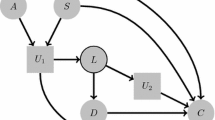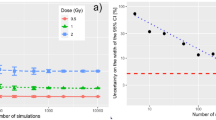Abstract
It has generally been assumed that the neutron and γ-ray absorbed doses in the data from the life span study (LSS) of the Japanese A-bomb survivors are too highly correlated for an independent separation of the all solid cancer risks due to neutrons and due to γ-rays. However, with the release of the most recent data for all solid cancer incidence and the increased statistical power over previous datasets, it is instructive to consider alternatives to the usual approaches. Simple excess relative risk (ERR) models for radiation-induced solid cancer incidence fitted to the LSS epidemiological data have been applied with neutron and γ-ray absorbed doses as separate explanatory covariables. A simple evaluation of the degree of independent effects from γ-ray and neutron absorbed doses on the all solid cancer risk with the hierarchical partitioning (HP) technique is presented here. The degree of multi-collinearity between the γ-ray and neutron absorbed doses has also been considered. The results show that, whereas the partial correlation between the neutron and γ-ray colon absorbed doses may be considered to be high at 0.74, this value is just below the level beyond which remedial action, such as adding the doses together, is usually recommended. The resulting variance inflation factor is 2.2. Applying HP indicates that just under half of the drop in deviance resulting from adding the γ-ray and neutron absorbed doses to the baseline risk model comes from the joint effects of the neutrons and γ-rays—leaving a substantial proportion of this deviance drop accounted for by individual effects of the neutrons and γ-rays. The average ERR/Gy γ-ray absorbed dose and the ERR/Gy neutron absorbed dose that have been obtained here directly for the first time, agree well with previous indirect estimates. The average relative biological effectiveness (RBE) of neutrons relative to γ-rays, calculated directly from fit parameters to the all solid cancer ERR model with both colon absorbed dose covariables, is 65 (95 %CI: 11; 170). Therefore, although the 95 % CI is quite wide, reference to the colon doses with a neutron weighting of 10 may not be optimal as the basis for the determination of all solid cancer risks. Further investigations into the neutron RBE are required, ideally based on the LSS data with organ-specific neutron and γ-ray absorbed doses for all organs rather than the RBE weighted absorbed doses currently provided. The HP method is also suggested for use in other epidemiological cohort analyses that involve correlated explanatory covariables.

Similar content being viewed by others
References
Arisawa K, Soda M, Shirahama S, Saito H, Takamura N, Yamaguchi M, Odagiri K, Nakagoe T, Suyama A, Doi H (2002) Geographic distribution of the incidence of adult T-cell leukemia/lymphoma and other malignancies in Nagasaki Prefecture, Japan. Jpn J Clin Oncol 32:301–306
Belsley DA, Kuh E, Welsch RE (2004) Regression diagnostics: identifying influential data and sources of collinearity. Wiley, Hoboken
Budescu DV (1993) Dominance analysis: a new approach to the problem of relative importance of predictors in multiple regression. Psychol Methods 8:542–551
Chevan A, Sutherland M (1991) Hierarchical Partitioning. The American Statistician 45(2):90–96
Dormann CF, Kühn I (2009) Angewandte Statistik für die biologischen Wissenschaften 2. durchgesehene, aktualisierte, überarbeitete und erweiterte Auflage 2009
Edwards AA (1999) Neutron RBE values and their relationship to judgements in radiological protection. J Radiol Prot 19(2):93–105
Hunter N, Charles MW (2002) The impact of possible modifications to the DS86 dosimetry on neutron risk and relative biological effectiveness. J Radiol Protect 22(4):357
International Commission on Radiological Protection (2007) the 2007 recommendations of the international commission on radiological protection. ICRP_103 Annals of the ICRP 37:2–4
Katz MH (2011) Multivariable analysis: a practical guide for clinicial and public health researchers, 3rd edn. Cambridge University Press, New York
Kellerer AM, Walsh L (2001) Risk estimation for fast neutrons with regard to solid cancer. Radiat Res 156:708–717
Kellerer AM, Walsh L (2002) Solid cancer risk coefficient for fast neutrons, in terms of effective dose. Radiat Res 158:61–68
Kellerer AM, Rühm W, Walsh L (2006) Indications of the neutron effect contribution in the solid cancer data of the A-bomb survivors. Health Phys 90(6):554–564
Murray K, Conner M (2009) Methods to quantify variable importance: implications for the analysis of noisy ecological data. Ecology 90(2):348–355
O’Brien RM (2007) A caution regarding rules of thumb for variance inflation factors. Qual Quant 41:673–690
Ozasa K, Shimizu Y, Suyama A, Kasagi F, Soda M, Grant EJ, Sakata R, Sugiyama H, Kodama K (2012) Studies of the mortality of atomic bomb survivors, report 14, 1950–2003: an overview of cancer and noncancer diseases. Radiat Res 177(3):229–243
Pierce DA, Shimizu Y, Preston DL, Vaeth M, Mabuchi K (1996) Studies of the mortality of atomic bomb survivors. Report 12, Part 1. Cancer 1950–1990. Radiat Res 146:1-27
Preston DL, Lubin JH, Pierce DA (1993) Epicure user’s guide. HiroSoft International Corp, Seattle
Preston DL, Shimizu Y, Pierce DA, Suyama A, Mabuchi K (2003) Studies of the mortality of atomic bomb survivors. Report 13: solid cancer and noncancer disease mortality: 1950–1997. Radiat Res 160:381–407
Preston DL, Pierce DA, Shimizu Y, Cullings HM, Fujita S, Funamoto S, Kodama K (2004) Effects of recent changes in atomic bomb survivors dosimetry on cancer mortality risk estimates. Radiat Res 162:377–389
Preston DL, Ron E, Tokuoka S, Funamoto S, Nishi N, Soda M, Mabuchi K, Kodama K (2007) Solid cancer incidence in atomic bomb survivors: 1958–1998. Radiat Res 168:1–64
Rühm W, Walsh L (2007) Current risk estimates based on the A-bomb survivors data—a discussion in terms of the ICRP recommendations on the neutron weighting factor. Proceedings of the Tenth Symposium on Neutro Dosimetry, Uppsala, Sweden. June 12–16, 2006. Radiat Prot Dosim 126(1–4):423–431
Thompson DE, Mabuchi K, Ron E, Soda M, Tokunaga M, Ochikubo S, Sugimoto S, Ikeda T, Terasaki M, Izumi S, Preston DL (1994) Cancer incidence in atomic bomb survivors. Part II: solid Tumors, 1958–1987. Radiat Res 137:S17–S67
Walsh L (2007) A short review of model selection techniques for radiation epidemiology. Radiat Environ Biophys 46:205–213
Walsh L, Kaiser JC (2011) Multi-model inference of adult and childhood leukaemia excess relative risks based on the Japanese A-bomb survivors mortality data (1950–2000). Radiat Environ Biophys 50:21–35
Walsh L, Rühm W, Kellerer AM (2004) Cancer risk estimates for γ-rays with regard to organ specific doses, part I: all solid cancers combined. Radiat Environ Biophys 43:145–151
Young R, Kerr GD (eds) (2005) DS02: Reassessment of the atomic bomb radiation dosimetry for Hiroshima and Nagasaki, Dosimetry System 2002, DS02 vols 1 and 2, Radiation Effects Research Foundation, Hiroshima
Zar JH (1999) Biostatistical analysis. Prentice Hall, Upper Saddle River
Acknowledgments
The author is grateful to Prof. Robert M. O’Brien, University of Oregon, U.S.A., Prof. William Kleiber, University of Colorado at Boulder, U.S.A. and Prof. Werner Rühm for useful discussions. This work has been partially supported by the European Union project FP7-ANDANTE (Multidisciplinary evaluation of the cancer risk from neutrons relative to photons using stem cells and the analysis of second malignant neoplasms following paediatric radiation therapy). This work makes use of the data obtained from the Radiation Effects Research Foundation (RERF) in Hiroshima, Japan. RERF is a private foundation funded equally by the Japanese Ministry of Health and Welfare and the US Department of Energy through the US National Academy of Sciences. The conclusions in this work are those of the author and do not necessarily reflect the scientific judgement of RERF or its funding agencies.
Author information
Authors and Affiliations
Corresponding author
Rights and permissions
About this article
Cite this article
Walsh, L. Neutron relative biological effectiveness for solid cancer incidence in the Japanese A-bomb survivors: an analysis considering the degree of independent effects from γ-ray and neutron absorbed doses with hierarchical partitioning. Radiat Environ Biophys 52, 29–36 (2013). https://doi.org/10.1007/s00411-012-0445-6
Received:
Accepted:
Published:
Issue Date:
DOI: https://doi.org/10.1007/s00411-012-0445-6




